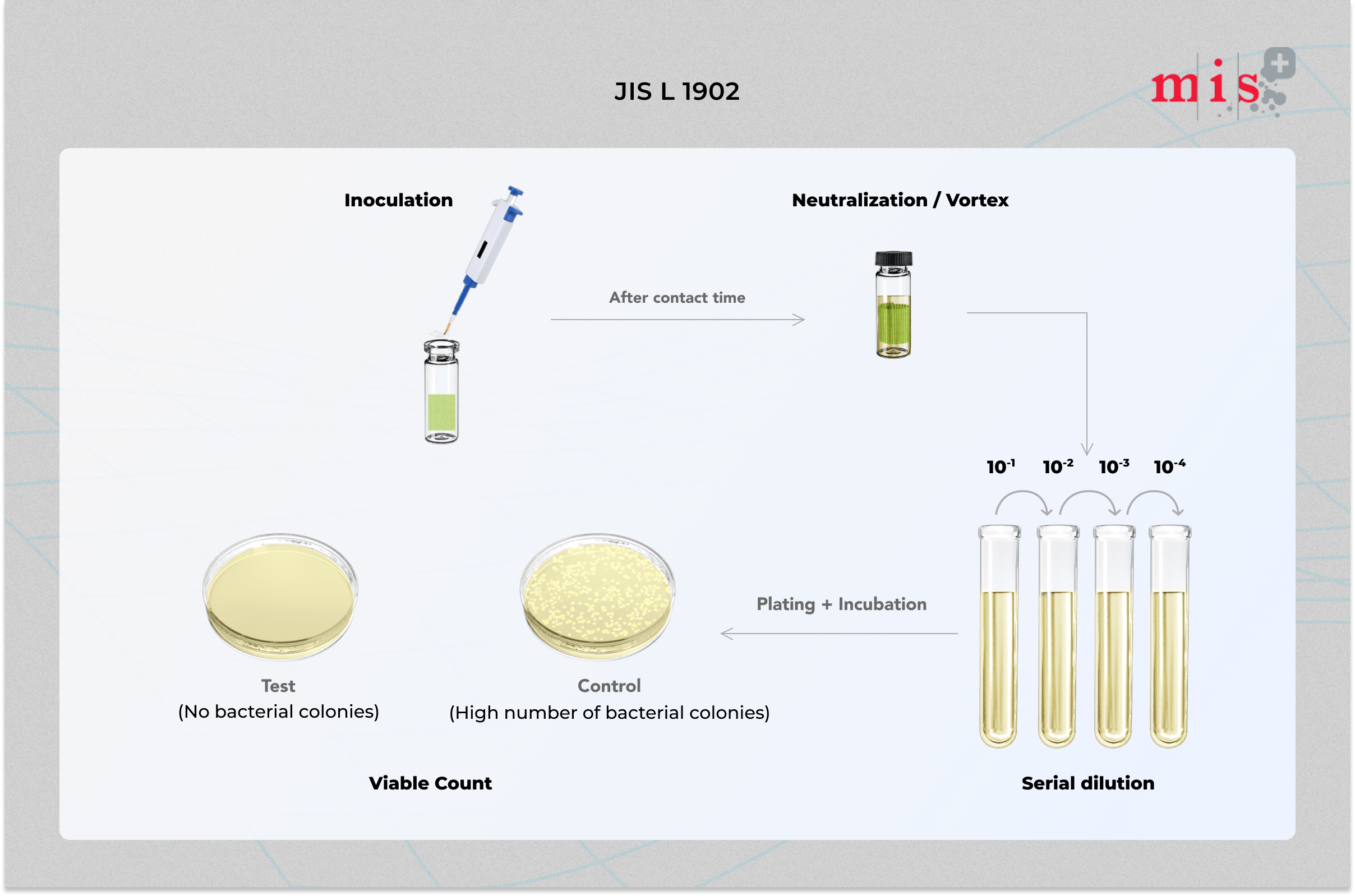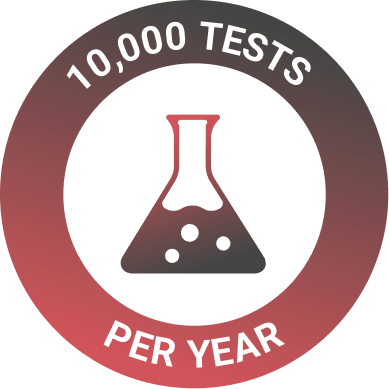JIS L 1902 Test
Determination of Antibacterial Activity of Antibacterial
Finished Products (Textiles)
JIS L 1902 – Determination of Antibacterial Activity of Antibacterial Finished Products (Textiles)
1. JIS L 1902 specifies quantitative test method to determine the antibacterial activity of antibacterial finished textile products, including nonwovens.
2. It is appropriate for all textile products, such as cloth, wadding, thread and material for clothing, home furnishings and various goods independently of the type of antimicrobial agent used (organic or inorganic, natural or artificial) or the method of application (built-in, after-treatment or grafting).
3. It depends on the projected application and on the environment where the textile product is intended to be used.
4. Customers can choose an appropriate method for determination of antimicrobial activity: Absorption method: evaluation method, bacterial suspension is inoculated directly onto samples, The Colony Plate Count method and the Adenosine Triphosphate Luminescence method are also specified for quantifying the bacterial enumeration.
ISO 20743 and JIS L 1902 are two identical test methods used for antimicrobial activity assessment of textiles. The only difference is that ISO 20743 uses three test methods (absorption, transfer, & printing) for antibacterial determination. While for JIS L 1902 standard, Halo method is combined with these three methods.
But to choose an ideal test method for evaluating the antibacterial efficacy of Face Masks read our comparison post: Face Mask Antibacterial Testing: ISO 20743 vs. JIS L 1902
Different Methods of Testing for JIS L 1902
- Absorption Method – In this evaluation method, test bacteria are inoculated directly onto the samples.
- Transfer Method – An evaluation method in which test bacteria are placed on an agar plate and then transferred onto the samples.
- Printing Method – In this method, test bacteria are placed on a filter and printed onto samples.
- Halo Method – This is a qualitative method that evaluates the antibacterial activity by the “zone of inhibition” around the treated sample. For JIS L 1902 Halo Method, test bacteria are inoculated into molten agar and covered by the test samples once agar gets solidified. These plates are incubated for 24- 48 hours to measure the zone of inhibition (halo).
Advantages of JIS L 1902 Test
- With JIS L 1902 test method, both bacteriostatic (growth-inhibiting) and bactericidal (bacteria-killing) properties on a given treated finished textile fabric can be determined.
- JIS L 1902 test method has a fast turnaround time and is also ideal for large sample quantities.

JIS L 1902 Test Procedure
- 6 test specimens of treated (antibacterial) and 6 control samples of untreated (without antibacterial agents) fabric are needed.
- All sample materials are subjected to sterilization to avoid any contamination.
- Test bacterial suspension of a known titre is directly inoculated on the sample material.
- For zero minute titre determination, (control and treated) samples are subjected to immediate wash with 20 ml of neutralizing media (SCDLP broth) after bacterial inoculation. Other remaining six specimens (3 control and 3 testing samples) are incubated at 37 °C ± 2 °C for 18 h to 24 h with the test bacterial suspension
- After an incubation period of 18-24 h, the reaction is stopped by adding 20 ml of neutralizing media Soya Casein Digest Lecithin Polysorbate Broth (SCDLP) into tubes. Then, the tubes are shaken to ensure proper mixing.
- Serial dilution and plating are done to determine titre of the remnant viable bacteria post the contact time
- The decrease in microorganism growth is compared to the control fabric.
With the growing awareness of bacterial diseases and their hazards to mankind, there is an increased demand for antibacterial fabrics. But before these antibacterial treated clothes are put into use, standard methods are used to evaluate their antibacterial efficacy.
At Microbe Investigations, we have the facilities and resources to perform all different antimicrobial fabric tests such as JIS L 1902, AATCC 100, ISO 20743, and so on. Our research and test laboratories encompass all the essential equipments, tools, and technical experts to deliver comprehensive solutions to meet the needs of our customers.
Consult our experts for additional details on our antimicrobial fabric testing services.
FAQs
The JIS L 1902 is a ‘quantitative test used to determine the antibacterial activity of all antibacterial textile products’. It is designed to test the ability of fabrics that have been treated with antimicrobial agents to prevent microbial growth and to kill microorganism .
JIS L 1902 test method is used to check the antibacterial activity of all finished textile materials such as cloth, wadding, thread, bedclothes, home furnishings, and miscellaneous goods.
The JIS L 1902 test takes 3 to 4 days.
At Microbe Investigations, we test for the JIS L 1902 using the following viruses: Pseudomonas aeruginosa (ATCC 15442), Escherichia coli (ATCC 8739), Staphylococcus aureus (ATCC 6538P), Enterococcus hirae (ATCC 10541), Klebsiella pneumoniae (ATCC 4352), MRSA (ATCC 33591), Salmonella enterica ( ATCC 10708), Candida Albicans (MTCC 3017). Additional strains can be added on request.
Contact us for more information
Related Post
Explore Other Tests
ASTME2149 | AATCC-100 | JISZ2801 | JISL1902 | EN 1276 | ISO 22196 | ISO 20743 | ISO 846 | ASTM E2180 | AATCC 147 | ASTM D7907-14 | ASTM E3031 | ASTM G29 | EN 16615 | EN 13697 | PAS 2424 | EN 1040 | EN 14349 | EN 13727 | EN 14561 | ASTM G22 | ASTM E1153 | ASTM D2574 | AATCC 174 | EN 14563 | EN 13704 | EN 1499 | EN 1500 | EN 14347 | EN 14348 | EN 1656 | EN 16437 | EN 12791 | ASTM E1174 | ASTM E2362
Antifungal Testing
AATCC 30 | ASTM G21 | EN 1650 | EN 1657 | EN 13624 | EN 1275 | ASTM C1338 | ASTM D5590






